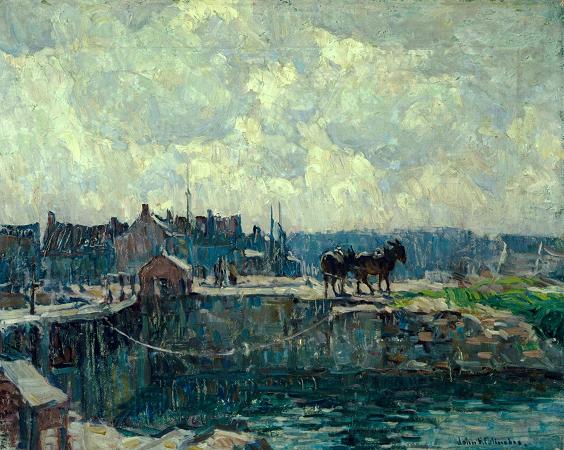Canal. Canals are waterways channels, or artificial waterways, for water conveyance, or to service water transport vehicles. They may also help with irrigation. It can be thought of as an artificial version of a river. In most cases, the engineered works will have a series of dams and locks that create reservoirs of low speed current flow. These reservoirs are referred to as slack water levels, often just called levels. A canal is also known as a navigation when it parallels a river and shares part of its waters and drainage basin, and leverages its resources by building dams and locks to increase and lengthen its stretches of slack water levels while staying in its valley. In contrast, a canal cuts across a drainage divide atop a ridge, generally requiring an external water source above the highest elevation. Many canals have been built at elevations towering over valleys and other water ways crossing far below. Canals with sources of water at a higher level can deliver water to a destination such as a city where water is needed. The Roman Empire's aqueducts were such water supply canals. A navigation is a series of channels that run roughly parallel to the valley and stream bed of an unimproved river. A navigation always shares the drainage basin of the river. A vessel uses the calm parts of the river itself as well as improvements, traversing the same changes in height. A true canal is a channel that cuts across a drainage divide, making a navigable channel connecting two different drainage basins. Most commercially important canals of the first half of the 19th century were a little of each, using rivers in long stretches, and divide crossing canals in others. This is true for many canals still in use. Canals are an efficient way of traveling as it was easier for people to get to areas faster than horse wagons. Both navigations and canals use engineered structures to improve navigation: weirs and dams to raise river water levels to usable depths; looping descents to create a longer and gentler channel around a stretch of rapids or falls; locks to allow ships and barges to ascend/descend. Since they cut across drainage divides, canals are more difficult to construct and often need additional improvements, like viaducts and aqueducts to bridge waters over streams and roads, and ways to keep water in the channel. There are two broad types of canal: Waterways: canals and navigations used for carrying vessels transporting goods and people. These can be subdivided into two kinds: Those connecting existing lakes, rivers, other canals or seas and oceans. Those connected in a city network: such as the Canal Grande and others of Venice Italy; the grachten of Amsterdam or Utrecht, and the waterways of Bangkok. Aqueducts: water supply canals that are used for the conveyance and delivery of potable water for human consumption, municipal uses, hydro power canals and agriculture irrigation. Historically canals were of immense importance to commerce and the development, growth and vitality of a civilization. In 1855 the Lehigh Canal carried over 1.2 million tons of anthracite coal; by the 1930s the company which built and operated it over a century pulled the plug. The few canals still in operation in our modern age are a fraction of the numbers that once fueled and enabled economic growth, indeed were practically a prerequisite to further urbanization and industrialization. For the movement of bulk raw materials such as coal and ores are difficult and marginally affordable without water transport. Such raw materials fueled the industrial developments and new metallurgy resulting of the spiral of increasing mechanization during 17th-20th century, leading to new research disciplines, new industries and economies of scale, raising the standard of living for any industrialized society. The surviving canals including most ship canals, today primarily service mostly bulk cargo and large ship transportation industries, whereas the once critical smaller inland waterways conceived and engineered as boat and barge canals have largely been supplanted and filled in, abandoned and left to deteriorate, or kept in service and staffed by state employees, where dams and locks are maintained for flood control or pleasure boating. Their replacement was gradual, beginning first in the United States in the mid-1850s where canal shipping was first augmented by, then began being replaced by using much faster, less geographically constrained & limited, and generally cheaper to maintain railways.
more...













